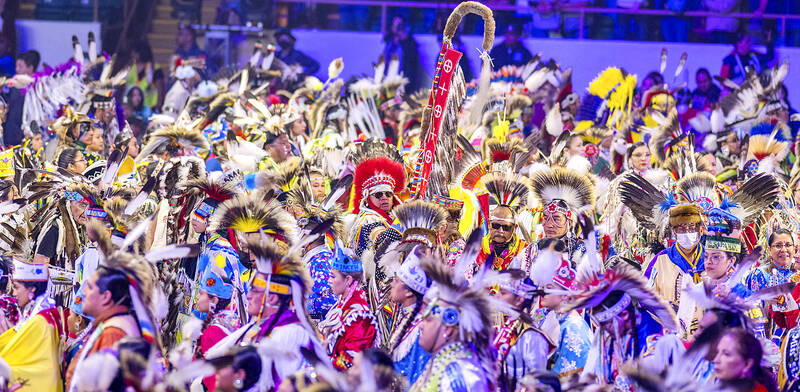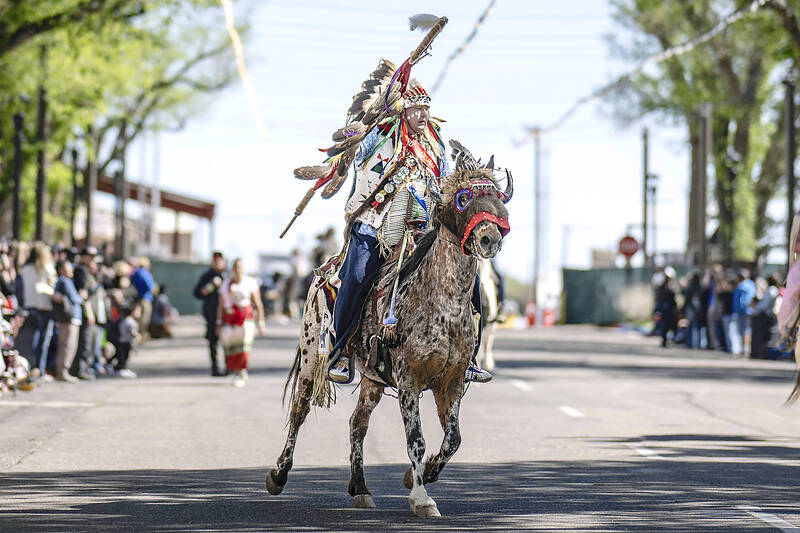Thousands of people are gathering in New Mexico for a celebration showcasing Native American and Indigenous dancers, musicians and artisans from around the world.
Billed by organizers as the largest powwow in North America, the annual Gathering of Nations festival kicked off yesterday with a colorful procession of dancers spiraling into the center of an arena at the New Mexico state fairgrounds. Participants wear elaborate regalia adorned with jingling bells and dance to the tempo of rhythmic drumming.
The event also features the crowning of Miss Indian World, as well as horse parades in which riders are judged on the craftsmanship of their intricately beaded adornments or feathered headdresses and how well they work with their horses.

Photo: AP
POWWOW ROOTS
Powwows are a relatively modern phenomenon that emerged in the 1800s as the US government seized land from tribes throughout the Northern and Southern Plains. Forced migrations and upheaval during this period resulted in intertribal solidarity among Plains people and those from the southern prairies of Canada.
Alliances were formed, giving way to the exchange of songs and dances during gatherings between different tribes. In the decades that followed, powwows were advertised to pioneers heading westward as “authentic” Native American dance shows. For some, it was an exploitation of their cultures.

Photo: AP
The word powwow was derived from pauwau, an Algonquian Narrtick word for “medicine man,” according to the Smithsonian Center for Folklife and Cultural Heritage. Scholars say English settlers misused the word to refer to the meetings of medicine men and later to any kind of Native American gathering.
Today, some of the large powwows like the Gathering of Nations have become more commercialized events that use dancing and drumming competitions with big prize money to provide a glimpse into Indigenous cultures.
RECONNECTING WITH CULTURE
At ceremonial dances, participants wear traditional regalia specific to their tribe, whereas powwow attire often is more contemporary and flashy with sequins and sparkles. It’s about dressing to impress the judges, said Warren Queton, a Kiowa Tribe legislator and adjunct instructor at the University of Oklahoma who has participated in community dancing and cultural events since he was a boy.
Queton, who served as the head gourd dancer at the university’s recent spring powwow, said ceremonial dances are deeply rooted in community, identity and cultural values.
It’s a struggle to keep traditional cultural practices and commercial powwows from being lumped into the same category, he said. They have very different meanings in Native American and Indigenous cultures.
There has been a focus on promoting smaller powwows held in tribal communities. Queton said these gatherings serve as a way for people who live elsewhere to return home and reconnect with their families and the land, and to share traditions with younger generations.
“Knowing where you come from, your land, your oral traditions, your language, but also values and traits — that can only be learned from a community,” he said. “That’s why those smaller dances are so important because people learn those community values. They’re all a part of our identity.”
CAPTURING GOOD ENERGY
There still are elements of tradition woven in to modern powwows. Competitors wear feathered bustles, buckskin dresses, fringed shawls and beaded head and hair pieces. Some of the elaborate outfits are hand-stitched designs that can take months to complete.
The sounds, movements and emotions that radiate from the dancing are challenging to capture on canvas. But Cochiti Pueblo painter Mateo Romero did just that when he partnered with the U.S. Postal Service to create a series of powwow stamps to be unveiled Friday during Gathering of Nations.
Powerfully hypnotic, atavistic and somatic is how the artist describes the dancing. One of his pieces depicts what is known as a fancy shawl dance with its dips, pivots, hops and twirls. Each tassel on the shawl flows and flips, accentuating the dancer’s movements.
Romero said he used color, thick and thin paint and soft and hard edges along with photographic elements to create something that feels alive, embedded with feeling and bright pops of color.
Romero called it a huge honor to transform powwow culture into a postage stamp filled with “good energy.”
“I look at it as a sort of vehicle to express this sentiment, the energy, the celebration, the vibration, the beauty of it,” he said. “It’s the power of it.”

It is jarring how differently Taiwan’s politics is portrayed in the international press compared to the local Chinese-language press. Viewed from abroad, Taiwan is seen as a geopolitical hotspot, or “The Most Dangerous Place on Earth,” as the Economist once blazoned across their cover. Meanwhile, tasked with facing down those existential threats, Taiwan’s leaders are dying their hair pink. These include former president Tsai Ing-wen (蔡英文), Vice President Hsiao Bi-khim (蕭美琴) and Kaohsiung Mayor Chen Chi-mai (陳其邁), among others. They are demonstrating what big fans they are of South Korean K-pop sensations Blackpink ahead of their concerts this weekend in Kaohsiung.

Taiwan is one of the world’s greatest per-capita consumers of seafood. Whereas the average human is thought to eat around 20kg of seafood per year, each Taiwanese gets through 27kg to 35kg of ocean delicacies annually, depending on which source you find most credible. Given the ubiquity of dishes like oyster omelet (蚵仔煎) and milkfish soup (虱目魚湯), the higher estimate may well be correct. By global standards, let alone local consumption patterns, I’m not much of a seafood fan. It’s not just a matter of taste, although that’s part of it. What I’ve read about the environmental impact of the

Oct 20 to Oct 26 After a day of fighting, the Japanese Army’s Second Division was resting when a curious delegation of two Scotsmen and 19 Taiwanese approached their camp. It was Oct. 20, 1895, and the troops had reached Taiye Village (太爺庄) in today’s Hunei District (湖內), Kaohsiung, just 10km away from their final target of Tainan. Led by Presbyterian missionaries Thomas Barclay and Duncan Ferguson, the group informed the Japanese that resistance leader Liu Yung-fu (劉永福) had fled to China the previous night, leaving his Black Flag Army fighters behind and the city in chaos. On behalf of the

The captain of the giant Royal Navy battleship called his officers together to give them a first morsel of one of World War II’s most closely guarded secrets: Prepare yourselves, he said, for “an extremely important task.” “Speculations abound,” one of the officers wrote in his diary that day — June 2, 1944. “Some say a second front, some say we are to escort the Soviets, or doing something else around Iceland. No one is allowed ashore.” The secret was D-Day — the June 6, 1944, invasion of Nazi-occupied France with the world’s largest-ever sea, land and air armada. It punctured Adolf